Mechanism of the Impact-Sensitivity Reduction of Energetic CL-20/TNT Cocrystals: A Nonequilibrium Molecular Dynamics Study
Abstract
1. Introduction
2. Calculation Methods and Simulation Details
3. Results and Discussion
3.1. Verify the Reliability of Calculation Results
3.2. Changes in the Species
3.3. Analysis of the Bonds
3.4. Elementary Reactions
3.5. Initial Reaction Steps
4. Conclusions
Supplementary Materials
Author Contributions
Funding
Institutional Review Board Statement
Data Availability Statement
Conflicts of Interest
References
- Bennion, J.; Matzger, A. Development and evolution of energetic cocrystals. Acc. Chem. Res. 2021, 54, 1699–1710. [Google Scholar] [CrossRef]
- Wang, Q.; Feng, X.; Wang, S.; Song, N.; Chen, Y.; Tong, W.; Han, Y.; Yang, L.; Wang, B. Metal-organic framework templated synthesis of copper azide as the primary explosive with low electrostatic sensitivity and excellent initiation ability. Adv. Mater. 2016, 28, 5837–5843. [Google Scholar] [CrossRef] [PubMed]
- Nielsen, A.; Chafin, A.; Christian, S.; Moore, D.; Nadler, M.; Nissan, R.; Vanderah, D. Synthesis of polyazapolycyclic caged polynitramines. Tetrahedron 1998, 54, 11793–11812. [Google Scholar] [CrossRef]
- Bolton, O.; Matzger, A. Improved stability and smart-material functionality realized in an energetic cocrystal. Angew. Chem. Int. Ed. 2011, 50, 8960–8963. [Google Scholar] [CrossRef] [PubMed]
- Wang, F.; Du, G.; Liu, X.; Shao, M.; Zhang, C.; Chen, L. Molecular dynamics application of cocrystal energetic materials: A review. Nanotechnol. Rev. 2022, 11, 2141–2153. [Google Scholar] [CrossRef]
- Li, L.; Ling, H.; Tao, J.; Pei, C.; Duan, X. Microchannel-confined crystallization: Shape-controlled continuous preparation of a high-quality CL-20/HMX cocrystal. Cryst. Eng. Comm. 2022, 24, 1523–1528. [Google Scholar] [CrossRef]
- Tan, Y.; Yan, Z.; Wang, H.; Li, H.; Nie, F.; Liu, Y. High energy explosive with low sensitivity: A new energetic cocrystal based on CL-20 and 1,4-DNI. Cryst. Growth. Des. 2019, 19, 4476–4482. [Google Scholar] [CrossRef]
- Liu, N.; Duan, B.; Lu, X.; Zhang, Q.; Xu, M.; Mo, H. Preparation of CL-20/TFAZ cocrystals under aqueous conditions: Balancing high performance and low sensitivity. CrystEngComm 2019, 21, 7271–7279. [Google Scholar] [CrossRef]
- Li, Y.; Li, B.; Zhang, D.; Xie, L. Preparation and characterization of a series of high-energy and low-sensitivity composites with different desensitizers. New J. Chem. 2022, 46, 5218–5233. [Google Scholar] [CrossRef]
- Yang, Z.; Li, H.; Huang, H.; Zhou, X.; Li, J.; Nie, F. Preparation and performance of a HNIW/TNT cocrystal explosive. Prop. Explos. Pyrotech. 2013, 38, 495–501. [Google Scholar] [CrossRef]
- Hu, Y.; Yuan, S.; Li, X.; Liu, M.; Sun, F.; Yang, Y.; Hao, G.; Jiang, W. Preparation and characterization of nano-CL-20/TNT cocrystal explosives by mechanical ball-milling method. ACS Omega 2020, 5, 17761–17766. [Google Scholar] [CrossRef] [PubMed]
- Hang, G.; Yu, W.; Wang, T.; Wang, J.; Li, Z. Comparative studies on structures, mechanical properties, sensitivity, stabilities and detonation performance of CL-20/TNT cocrystal and composite explosives by molecular dynamics simulation. J. Mol. Model. 2017, 23, 281. [Google Scholar] [CrossRef] [PubMed]
- Guo, D.; An, Q.; Zybin, S.; Goddard, W.; Huang, F.; Tang, B. The co-crystal of TNT/CL-20 leads to decreased sensitivity toward thermal decomposition from first principles based reactive molecular dynamics. J. Mater. Chem. A 2015, 3, 5409–5419. [Google Scholar] [CrossRef]
- Guo, D.; An, Q.; Goddard, W.A.; Zybin, S.V.; Huang, F. Compressive shear reactive molecular dynamics studies indicating that cocrystals of TNT/CL-20 decrease sensitivity. J. Phys. Chem. C 2014, 118, 30202–30208. [Google Scholar] [CrossRef]
- Ren, C.; Li, X.; Guo, L. Chemical insight on decreased sensitivity of CL-20/TNT cocrystal revealed by ReaxFF MD simulations. J. Chem. Inf. Model. 2019, 59, 2079–2092. [Google Scholar] [CrossRef]
- Ren, C.; Liu, H.; Li, X.; Guo, L. Decomposition mechanism scenarios of CL-20 co-crystals revealed by ReaxFF molecular dynamics: Similarities and differences. Phys. Chem. Chem. Phys. 2020, 22, 2827–2840. [Google Scholar] [CrossRef]
- Zhang, X.; Chen, X.; Kaliamurthi, S.; Selvaraj, G.; Ji, G.; Wei, D. Initial decomposition of the co-crystal of CL-20/TNT: Sensitivity decrease under shock loading. J. Phys. Chem. C 2018, 122, 24270–24278. [Google Scholar] [CrossRef]
- Xue, X.; Ma, Y.; Zeng, Q.; Zhang, C. Initial decay mechanism of the heated CL-20/HMX cocrystal: A case of the cocrystal mediating the thermal stability of the two pure components. J. Phys. Chem. C 2017, 121, 4899–4908. [Google Scholar] [CrossRef]
- Wang, F.; Chen, L.; Geng, D.; Wu, J.; Lu, J.; Wang, C. Thermal decomposition mechanism of CL-20 at different temperatures by ReaxFF reactive molecular dynamics simulations. J. Phys. Chem. A 2018, 122, 3971–3979. [Google Scholar] [CrossRef]
- Wang, F.; Chen, L.; Geng, D.; Lu, J.; Wu, J. Effect of density on the thermal decomposition mechanism of e-CL-20: A ReaxFF reactive molecular dynamics simulation study. Phys. Chem. Chem. Phys. 2018, 20, 22600–22609. [Google Scholar] [CrossRef]
- Wang, F.; Chen, L.; Geng, D.; Lu, J.; Wu, J. Molecular dynamics simulations of an initial chemical reaction mechanism of shocked CL-20 crystals containing nanovoids. J. Phys. Chem. C 2019, 123, 23845–23852. [Google Scholar] [CrossRef]
- Bolotina, N.; Hardie, M.; Speer, R.; Pinkerton, A. Energetic materials: Variable-temperature crystal structures of γ- and ε-HNIW polymorphs. J Appl. Cryst. 2004, 37, 808–814. [Google Scholar] [CrossRef]
- Golovina, N.I.; Titkov, A.N.; Raevskii, A.V.; Atovmyan, L.O. Kinetics and mechanism of phase transitions in the crystals of 2,4,6-trinitrotoluene and benzotrifuroxane. J. Solid. State Chem. 1994, 113, 229–238. [Google Scholar] [CrossRef]
- Patil, D.G.; Brill, T.B. Thermal decomposition of energetic materials 53. Kinetics and mechanism of thermolysis of hexanitrohexazaisowurtzitane. Combust. Flame 1991, 87, 145–151. [Google Scholar] [CrossRef]
- Patil, D.G.; Brill, T.B. Thermal decomposition of energetic materials 59. Characterization of the residue of hexanitrohexaazaisowurtzitane. Combust. Flame 1993, 92, 456–458. [Google Scholar] [CrossRef]
- Turcotte, R.; Vachon, M.; Kwok, Q.S.M.; Wang, R.; Jones, D.E.G. Thermal study of HNIW (CL-20). Thermochim. Acta 2005, 433, 105–115. [Google Scholar] [CrossRef]
- Simpson, R.L.; Urtiew, P.A.; Ornellas, D.L.; Moody, G.L.; Scribner, K.J.; Hoffman, D.M. CL-20 performance exceeds that of HMX and its sensitivity is moderate. Prop. Explos. Pyrot. 1997, 22, 249–255. [Google Scholar] [CrossRef]
- Ornellas, D.L. The heat and products of detonation of cyclotetramethylenete tranitramine, 2,4,6-trinitrotoluene, nitromethane, and bis (2,2-dinitro-2-fluoroethyl) formal. J. Phys. Chem. 1968, 72, 2390–2394. [Google Scholar] [CrossRef]
- Wang, F.; Chen, L.; Geng, D.; Lu, J.; Wu, J. Chemical reactions of a CL-20 crystal under heat and shock determined by ReaxFF reactive molecular dynamics simulations. Phys. Chem. Chem. Phys. 2020, 22, 23323–23332. [Google Scholar] [CrossRef]
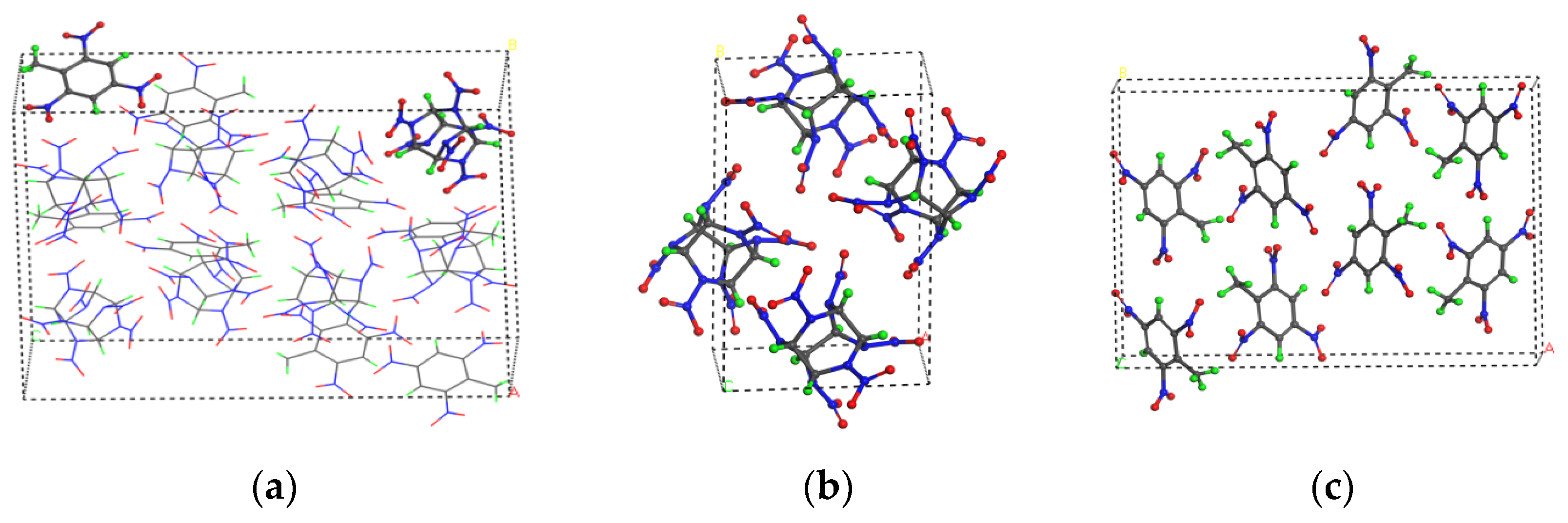
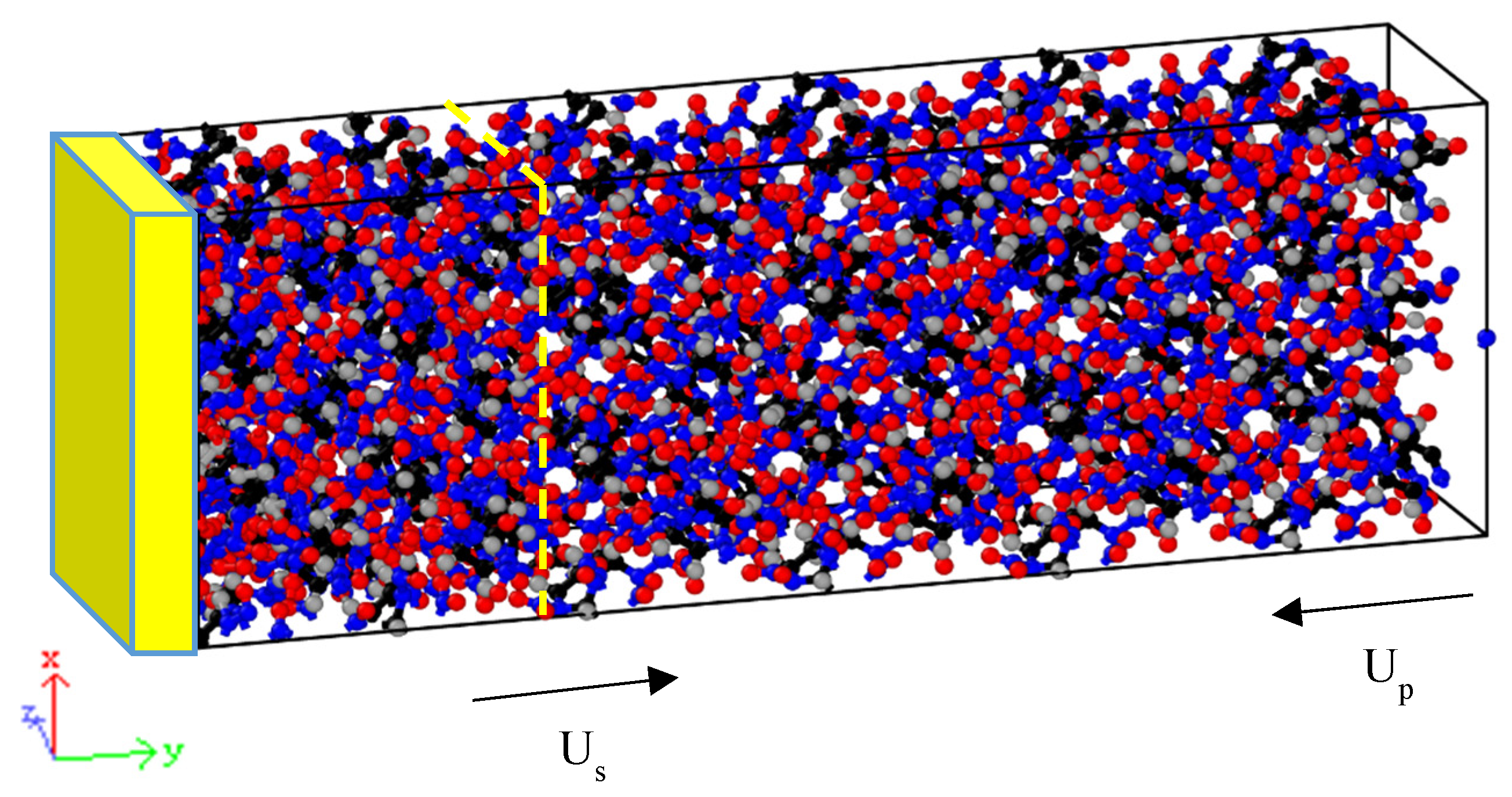
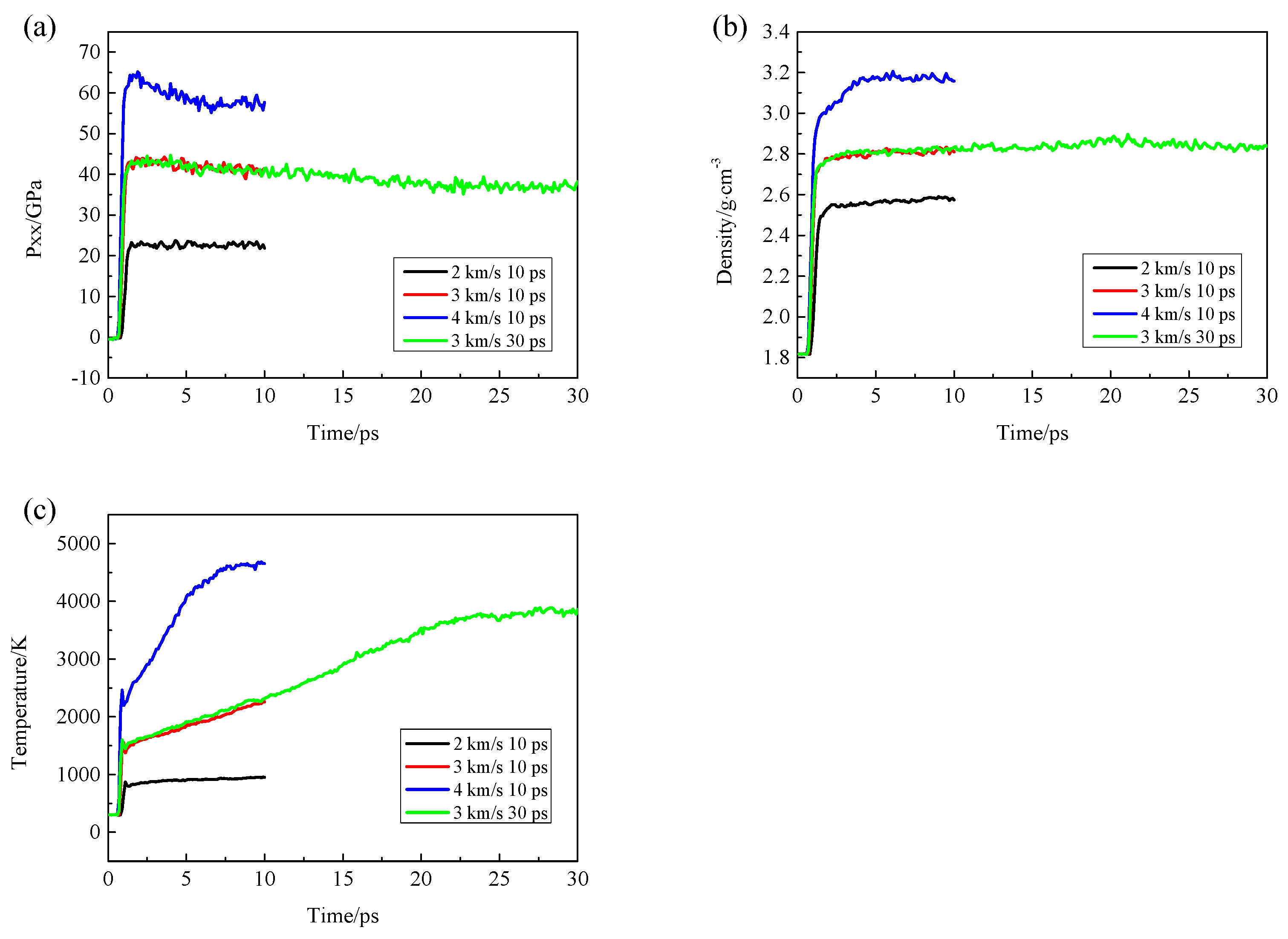

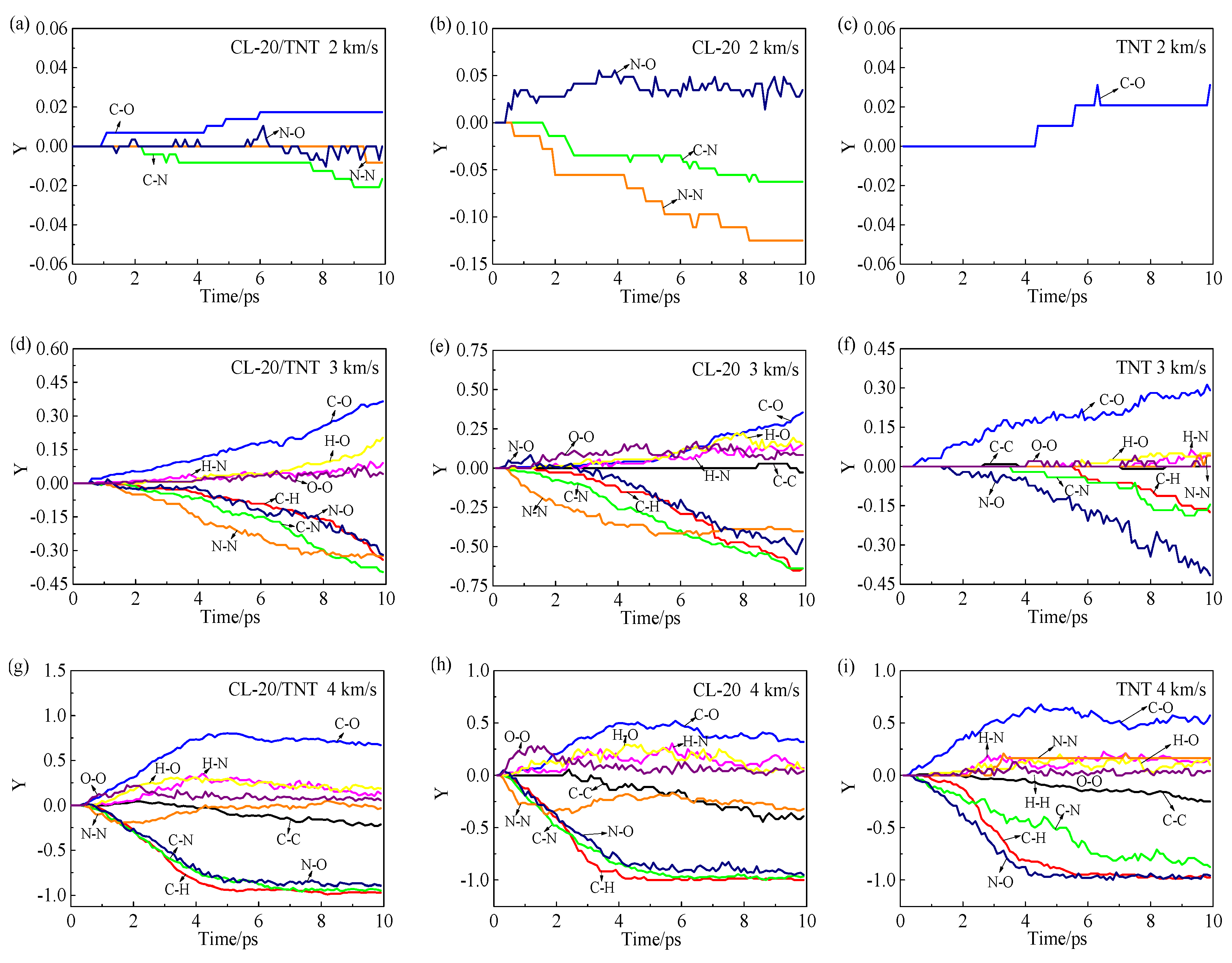
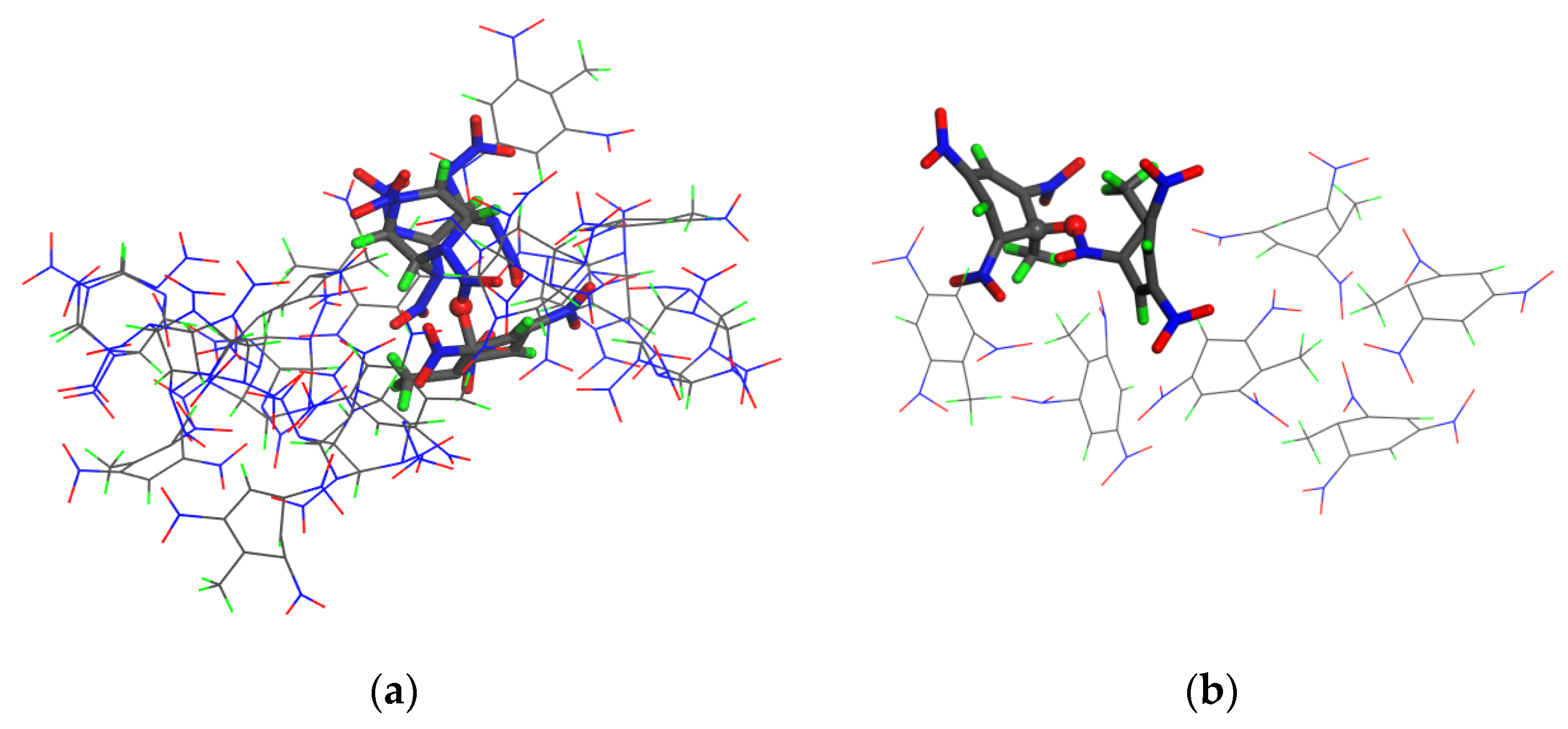

| Crystals | Methods | a/Å | b/Å | c/Å | Density/g·cm−3 |
|---|---|---|---|---|---|
| CL-20/TNT | Experiments | 9.674 | 19.369 | 24.690 | 1.910 |
| ReaxFF-lg | 9.836 | 19.693 | 25.103 | 1.818 | |
| CL-20 | Experiments | 8.863 | 12.593 | 13.395 | 2.035 |
| ReaxFF-lg | 9.038 | 12.842 | 13.660 | 1.919 | |
| TNT | Experiments | 20.041 | 15.013 | 6.084 | 1.648 |
| ReaxFF-lg | 19.689 | 14.750 | 5.977 | 1.738 |
| . | CL-20 | TNT | Sum | CL-20/TNT | ∆ |
|---|---|---|---|---|---|
| Energy (Kcal/mol) | −29,224.383 | −20,096.508 | −49,320.891 | −49,363.63 | 42.739 |
| Crystals | Bonds Styles | |||||||||
|---|---|---|---|---|---|---|---|---|---|---|
| C-C | C-H | C-N | C-O | H-H | H-N | H-O | N-N | N-O | O-O | |
| CL-20/TNT | 10 | 11 | 15 | 18 | 5.5 | 11 | 11 | 7.5 | 18 | 9 |
| CL-20 | 3 | 6 | 12 | 12 | 3 | 6 | 6 | 6 | 12 | 6 |
| TNT | 7 | 5 | 3 | 6 | 2.5 | 5 | 5 | 1.5 | 6 | 3 |
| Impact Velocities/km·s−1 | CL-20/TNT | CL-20 | TNT |
|---|---|---|---|
| 2 | C-O generation | N-O generation | C-O generation |
| C-N broken | N-N broken | − | |
| N-O generation | C-N broken | − | |
| N-N broken | − | − | |
| 3 | C-O generation | N-O generation | C-O generation |
| N-O generation | N-N broken | N-O broken | |
| C-N broken | C-N broken | C-N broken | |
| H-N generation | O-O generation | C-H broken | |
| N-N broken | C-O generation | H-O generation | |
| C-H broken | − | − | |
| O-O generation | − | − | |
| 4 | N-O generation, C-N broken | N-O generation | − |
| C-O generation | O-O generation, N-N broken, C-H broken | C-O generation | |
| O-O generation, N-N broken | H-N generation, C-N broken, C-O generation | N-O broken | |
| C-H broken | H-O generation | C-C broken, C-N broken | |
| C-C broken | C-C broken | C-H broken |
| Impact Velocities /km·s−1 | Crystal Species | First Occur | Highest Frequency |
|---|---|---|---|
| 2 | CL-20/TNT | Polymerization of component molecules | Polymerization and separation between component molecules |
| Decomposition of TNT to NO2 | |||
| CL-20 | Bimolecular polymerization | Multi-molecular polymerization | |
| CL-20 decomposition to NO2 | |||
| TNT | Bimolecular or multi-molecular polymerization | Intermolecular polymerization and separation | |
| 3 | CL-20/TNT | Polymerization of component molecules | NO2+NO2→N2O4 |
| CL-20 decomposition to NO2 | CL-20 decomposition to NO2 | ||
| — | Generation of N2O, N2 | ||
| CL-20 | Bimolecular polymerization | Bimolecular polymerization | |
| CL-20 decomposition to NO2 | O2+N2→N2O2 | ||
| NO, HO | |||
| TNT | Bimolecular or multi-molecular polymerization | Intermolecular polymerization and separation | |
| 4 | CL-20/TNT | Polymerization of component molecules | N2 and H |
| CL-20 decomposition to NO2 | O and H2 | ||
| CL-20 | Bimolecular polymerization | N2 and H or HO | |
| CL-20 decomposition to NO2 | O and H or H2 | ||
| H and HO | |||
| TNT | Bimolecular or multi-molecular polymerization | N and N, HN, H3 or H4 | |
| O and H2 |
Disclaimer/Publisher’s Note: The statements, opinions and data contained in all publications are solely those of the individual author(s) and contributor(s) and not of MDPI and/or the editor(s). MDPI and/or the editor(s) disclaim responsibility for any injury to people or property resulting from any ideas, methods, instructions or products referred to in the content. |
© 2023 by the authors. Licensee MDPI, Basel, Switzerland. This article is an open access article distributed under the terms and conditions of the Creative Commons Attribution (CC BY) license (https://creativecommons.org/licenses/by/4.0/).
Share and Cite
Wang, F.; Du, G.; Zhang, C.; Wang, Q.-Y. Mechanism of the Impact-Sensitivity Reduction of Energetic CL-20/TNT Cocrystals: A Nonequilibrium Molecular Dynamics Study. Polymers 2023, 15, 1576. https://doi.org/10.3390/polym15061576
Wang F, Du G, Zhang C, Wang Q-Y. Mechanism of the Impact-Sensitivity Reduction of Energetic CL-20/TNT Cocrystals: A Nonequilibrium Molecular Dynamics Study. Polymers. 2023; 15(6):1576. https://doi.org/10.3390/polym15061576
Chicago/Turabian StyleWang, Fuping, Guangyan Du, Chenggen Zhang, and Qian-You Wang. 2023. "Mechanism of the Impact-Sensitivity Reduction of Energetic CL-20/TNT Cocrystals: A Nonequilibrium Molecular Dynamics Study" Polymers 15, no. 6: 1576. https://doi.org/10.3390/polym15061576
APA StyleWang, F., Du, G., Zhang, C., & Wang, Q.-Y. (2023). Mechanism of the Impact-Sensitivity Reduction of Energetic CL-20/TNT Cocrystals: A Nonequilibrium Molecular Dynamics Study. Polymers, 15(6), 1576. https://doi.org/10.3390/polym15061576







